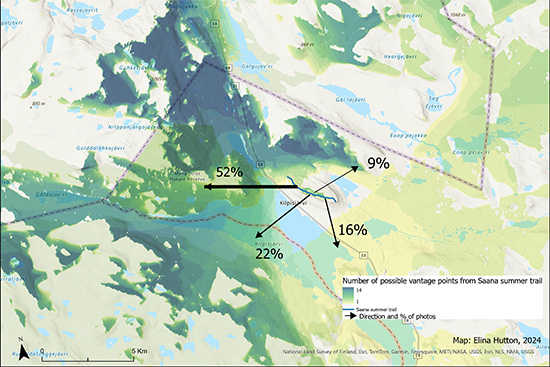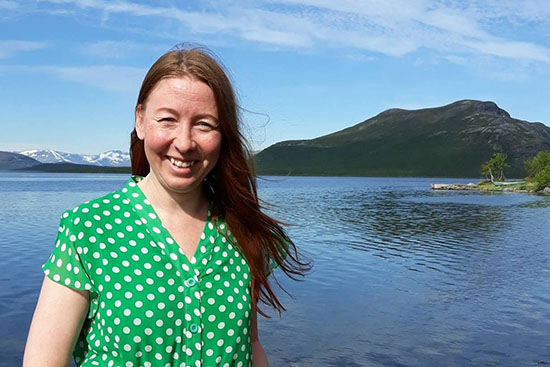Elina Hutton's doctoral dissertation examines nature tourism in the wilderness areas of Kilpisjärvi and Käsivarsi. One of the most photographed site in the area is Saana fell. Photo by Elina Hutton.
Tourists are increasingly choosing their destinations inspired by social media. Elina Hutton’s doctoral dissertation provides new insights into tourist behaviour, and tools for visitor management in protected natural areas.
The growth of nature tourism is a contradictory phenomenon. Its popularity has grown, and there is an understanding that time spent in nature increases, among other benefits, people's interest in nature conservation. At the same time, the disadvantages of tourism are increasing, and the loss of nature has become one of the great threats of our time.
Tourists increasingly form their understanding of destinations and its nature on social media. People inspired by social media travel to new destinations, take pictures and share them on social media. M.Soc.Sc. Elina Hutton became interested in this phenomenon and wanted to find out how social media impacts visitors and constructs relationships with nature. She was interested to study how could social media be used in visitor management of nature sites.
Hutton turned her gaze towards north-western Lapland: Lake Kilpisjärvi and the Käsivarsi wilderness area. She reviewed Facebook and Instagram posts from summer 2019 and analyzed them using new visitor monitoring tools. The result was clear.
“Social media has a major impact on tourists’ behaviour. When a destination is presented as a wild and pristine wilderness that exists only for the tourist, it builds a very superficial relationship with nature," Hutton summarizes.
According to Hutton, visitor management needs to take this into account. By visitor management, she refers to the tools used to manage visitor numbers and activities to ensure sustainability, safety and experiences in nature.
“Tourists should be provided with more contents that increase their understanding of biodiversity and local life, as well as deepens the relationship with nature.”
When landscape is highlighted, much remains invisible
Nature relationship built by social media is problematic. The operating logic of algorithms is that they give additional visibility to the most popular images. Thus, the images seen by the tourists become one-dimensional, strengthening the idea that just a certain kind landscape is desired.
The contemporary landscape photos in social media repeat the wilderness imagery of tourism marketing and landscape art in the Romantic era, portraying the landscapes as rugged and pristine.
“This does not help the tourist to understand the bigger picture, such as the importance of ecosystems. Instead, it promotes a superficial relationship with nature," Hutton says.
The research reveals that posts also seem to disconnect people from nature. When you can't see people, you can't see their impact on nature.
“As a result, the effects of tourism on nature are also invisible.”
In addition, social media marginalizes local and indigenous cultures.
“Local life is only visible in the services offered to tourists, and traditional livelihoods and culture, such as reindeer husbandry, are only used to highlight the exotic in the landscape”, Hutton says.
Multichannel communication on biodiversity
Hutton emphasizes that the pressure created by social media can be addressed through visitor management. She encourages highlighting diversity and challenging the landscape-focused nature imagery of social media wherever tourists move - not just on social media.
“When communicating along trails, at viewpoints, and in social media channels of national parks and sites, a more diverse nature image can be reinforced and a more nature-friendly relationship can be built.”
Hutton opens her thoughts with examples. There is a sign on Saana fell, a popular Finnish trail, provided by Parks and wildlife Finland, identifying the names of mountains from the neighbouring countries Sweden and Norway. Hutton would also like to see another sign that would introduce the landscape in other directions. She would place signposts that would indicate, for example, the signs of the melted glaciers or signs of vegetation changes.
Social media to help with visitor management
Commercial surveys have used social media to map travelers' opinions and experiences, but when it comes to using social media in national parks’ visitor surveys, it has been more limited. The few studies so far have used social media, for example, to investigate favorite sites and the areal or temporal distribution of visits.
Hutton's research provides new evidence on the usability of social media data and its limitations in visitor monitoring. She describes the data collection as challenging to say the least. While potential data volumes are high, social media platforms have restrictions. There are many uncertainties related to the use of new methods, such as machine vision and artificial intelligence. For this reason, Hutton kept a netnographic research diary alongside the novel methods to be able to revise the analyses of social media observations against the appearance of the same phenomena in Kilpisjärvi's everyday life.
Despite the challenges, she believes that social media is useful in developing visitor management.
“It enables the collection of large amounts of data and, for example making temporal comparisons of interests. The data can be used as part of visitor research, for example alongside a traditional visitor survey," she adds.
Hutton collected Instagram posts using a commercial app. She wanted to test how a regular visitor manager could independently use image analytics. Facebook data she collected manually based on what the platform's algorithm brought up.
Using Geographic Information System (GIS) analysis, Hutton explored how the nature image of social media strengthens or challenges the previous landscape art imagery. She studied where Instagram photos were taken and the direction in which they viewed. Using location-based visibility analysis, she studied what can be seen from the most popular locations and compared the results to the direction of the images shared in social media.

Visibility analysis has not been used in visitor surveys before. It is usually used, for example, to investigate potential landscape damage caused by construction. The picture shows that the dominant direction of the tourist gaze is towards the neighbouring countries alongside Saana, although the landscape also opens up to the Käsivarsi wilderness and the riverside.
In addition, Hutton used the GIS analysis to compare the Corine nature types of the village's local routes with the content of the images. A large part of the routes passes through lush groves towards the open mountain tops. Yet the ecologically rare fell-grove forest is rarely seen in social media.
“The result tells that the attention of the tourist is on open fell landscapes in Kilpisjärvi, not nature values.”

Elina Hutton, with the most popular fell landscape in the Käsivarsi in the background. Photo by Niko Nappu.
Information on the public examination
Elina Hutton will be defending her dissertation Outdoors goes online -Tourist gaze in social media for visitor monitoring and management with the permission of the Faculty of Social Sciences at the University of Lapland on Friday 4th of April 2025 at 12 noon in lecture room B 126 (Yliopistonkatu 8, Rovaniemi).
The opponent is Professor Anke Fischer, Swedish University of Agricultural Sciences, and the custos is Professor Outi Rantala, University of Lapland.
The public examination can be followed online at https://blogi.eoppimispalvelut.fi/ulapland/
Coffee will be served in Restaurant Felli after the public defense.
Information on the doctoral candidate
Elina Hutton graduated from the University of Jyväskylä in 2001 with a Master's degree in Social Sciences, major in Social Policy. She has worked in the business sector, especially in tourism development and marketing, in the public sector and in companies in Lapland and Northern Norway. She has also worked on projects for Metsähallitus (Parks and Wildlie Finland) and the Natural Resources Institute of Finland, at Reisa National Park in Norway and as a lecturer in sustainable tourism at the UiT, Norwegian Arctic University. Her current work as a tourism researcher at SALT Lofoten AS Tromsø focuses on developing visitor management in nature tourism destinations, while she also works as a part-time lecturer at the University of Lapland.
Further information
Elina Hutton, ehutton(at)ulapland.fi, +4795527096
Information on the publication
Elina Hutton (2025) Outdoors goes online - Tourist gaze in social media for visitor monitoring and management. Acta electronica Universitatis Lapponiensis 397. ISBN 978-952-337-470-6, ISSN 1796-6310. Rovaniemi, University of Lapland.
The permanent address of the publication: https://urn.fi/URN:ISBN:978-952-337-470-6